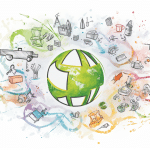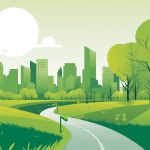Embracing Innovation for Environmental Wellness
In today’s world, where sustainability and environmental concerns are more pressing than ever, adopting a mindset geared towards sustainability and innovation is crucial. This blog post delves into how creative thinking and advanced technology can lead us to a cleaner, greener future.
The Power of Green Thinking
Green thinking involves looking at the world through a lens of sustainability. It’s about considering the long-term impact of our actions on the planet and seeking solutions that benefit humanity and the environment. This mindset is crucial in fostering innovations that lead to a more sustainable future. Green minds cleaner future means that present thinking affects later innovation.
It requires a mindset shift. It would help to become more aware of how your actions impact the environment. Many people in the developed world have never given that a second thought. There is a lot of resistance to the green movement, with many entities pushing back with their narratives. That means it will take changing minds ever to push the movement to mass acceptance.

Innovations Shaping a Cleaner World
Five things are happening that are setting the stage for green energy. The changes will come faster as more significant investments go into each industry. Each is creating controversy, mainly because this is the first time they are undergoing implementation on a wide scale.
- Renewable Energy Technologies: This sector increases as solar panels, thermal energy generation, and wind turbines become more efficient and affordable. Innovations in this sector are crucial. That’s how to reduce or eliminate the reliance on fossil fuels and decrease carbon emissions.
- Electric Vehicles (EVs): The rise of EVs represents a significant leap forward in reducing emissions from transportation. Continued advancements in battery technology and charging infrastructure are making EVs more accessible and practical.
- Smart Cities: Integrating technology into urban planning can lead to more efficient use of resources. Smart cities use IoT (Internet of Things) sensors and AI to manage traffic, save energy, and reduce waste.
- Recycling and Upcycling Innovations: New technologies are making recycling processes more efficient. Upcycling, turning waste materials into new, high-quality products, is also gaining traction as a creative and eco-friendly solution.
- Sustainable Agriculture: Innovations in agriculture, such as vertical farming and precision farming, use less land and water, helping to preserve natural resources while meeting the growing demand for food.
Cultivating a Culture of Environmental Innovation
To continue advancing towards a cleaner future, nurturing a culture that values and encourages green innovation is essential. You can achieve this through:
- Education and Awareness: Increasing public understanding of environmental issues and the importance of sustainability.
- Support for Green Startups: Providing resources and incentives for startups focused on environmental solutions.
- Collaboration: Encouraging collaboration between governments, businesses, and communities to implement sustainable practices.
All of these activities are crucial. An ongoing grassroots campaign will be required to alter attitudes. Only when that happens on a mass scale will widescale change happen. Passionate people who believe in the cause need to lead the charge.
A Collective Effort for a Sustainable Tomorrow
The journey to a cleaner future is collective, requiring the efforts of individuals, communities, industries, and governments. By fostering a green mindset and embracing innovative technologies, we can make significant strides in protecting our planet for future generations. Let’s work together towards a future where technology and sustainability go hand in hand, creating a world that’s not only advanced but also kind and considerate to our environment.
Frequently Asked Questions (FAQs): Unraveling Green Innovation
Renewable energy technologies, like solar panels and wind turbines, play a crucial role in reducing our carbon footprint. By harnessing natural resources like sunlight and wind, they generate clean, emission-free energy. This shift from fossil fuels to renewable sources significantly lowers greenhouse gas emissions, which are a major contributor to climate change.
Yes, electric vehicles are more eco-friendly compared to traditional gasoline-powered cars. EVs produce zero emissions at the point of use, which drastically reduces air pollution. Additionally, as the electricity grid becomes greener with more renewable energy sources, the overall environmental impact of EVs continues to decrease.
Smart cities use technology to enhance the efficiency and quality of urban services. Through IoT sensors, AI, and data analytics, they manage resources like energy and water more effectively, optimize waste management, and reduce traffic congestion. This leads to a significant reduction in the city’s overall carbon footprint and promotes a more sustainable urban environment.
Absolutely. Sustainable agriculture methods like vertical farming and precision farming are highly efficient and use fewer resources than traditional farming. These practices minimize land usage, conserve water, and reduce the need for chemical fertilizers, all while maintaining high productivity. This makes them a viable solution for meeting the increasing global food demands sustainably.





